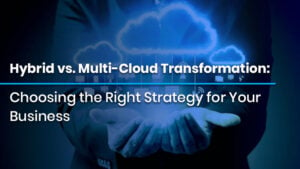
How to Strengthen Security Using CIS Controls and Posture Analysis
How to Strengthen Security Using CIS Controls and Posture Analysis Introduction In the fast-paced and ever-evolving world of cybersecurity, defending digital infrastructure goes far
Enhance your Skills in Cloud Computing , IP Networking , Microsoft , Artificial Intelligence , Cybersecurity and Many More . Come and Join IPSpecialist.

How to Strengthen Security Using CIS Controls and Posture Analysis Introduction In the fast-paced and ever-evolving world of cybersecurity, defending digital infrastructure goes far

How to Prepare for the AWS Data Engineer Exam Introduction With the world becoming increasingly data-driven, organizations are depending on cloud-based systems to store, process,

Hybrid vs. Multi-Cloud Transformation: Choosing the Right Strategy for Your Business Introduction In the digital-first economy of today, cloud transformation is no longer a
Table of Contents
Traditional monolithic application models are frequently used in server-based architectures. In this strategy, the entire application is deployed on one server or a collection of servers. Due to this, it may be challenging to expand specific application components, which increases server usage.
Microservices are the building blocks of serverless architectures. According to this architecture, every application component is deployed as a separate service. These services are called upon when certain things happen, including user requests or other system events. This enables more precise scaling of individual components and may result in lower overall server use.
In the modern era, a new concept called “Serverless Computing” has emerged that streamlines the work of cloud administrators and developers. Since managed services allow most organizations to concentrate on their core business operations in the least complicated and expensive manner, cloud computing already plays a significant role in most organizations. Serverless Computing offers capabilities that are considerably simpler to use. This article covers depth knowledge of Server and Serverless and their differences.
To know more about Serverless services, you can visit the IPSpecialist website. IPSpecialist is the best place to begin your career if you are interested in Cybersecurity, Networking, or related fields. We provide online courses, study guides, e-books, practice questions, exam-cram notes, and career guidance. Check out our Courses now!
Delegating server management and upkeep to a different cloud provider is called serverless architecture. Companies can concentrate on creating new products and writing code while the cloud provider manages the server infrastructure.
The cost of serverless computing is variable and depends on the company’s needs. Additionally, there is no need for costly hardware, high electricity costs, or an in-house IT department to maintain the servers.
The staff members will access files at any time and from any location. The servers are reachable from any device because the cloud provider is responsible for managing them.
Companies with remote employees and independent contractors who need access to critical information from any location should choose this option.
Delegating server upkeep is a key component of serverless, which subsequently cedes some control. For this reason, it is critical to research the businesses and work with a reputable, knowledgeable cloud provider.
Response latency might be a disadvantage of migrating to serverless computing. Response latency is the interval between a request’s stimulus and a program’s response. Serverless computing shuts off between requests in the cloud, which is not always active.
As a result, starting from unused serverless code may result in response lag. The time it takes to spin up and run code can be several seconds. This might work against serverless, depending on the particular use case, especially if the timing is important.
An application’s dependence on a provider will certainly grow if that vendor provides all backend services. Setting up a serverless architecture with one provider can make it challenging to transfer providers later because each vendor offers a little bit different features and processes.
Serverless is the way to go if companies anticipate growth and need a setting that can accommodate their demands while also meeting demand.
Let’s look at various serverless computing models provided by different cloud providers.
AWS Lambda was the first serverless computing architecture offered by Amazon, and it debuted in 2014.For developers to easily manage Lambda Functions, it supports programming languages like Java, Python, Node, Ruby, C#, Go, and PowerShell.
Azure Functions are available through Microsoft Azure, either in the Azure public cloud or on-premises with Azure Stack. Many versions of Azure support various programming languages, allowing for the development of Azure functions.
App Engine, Code Run, and Google Cloud Functions are services offered by Google Cloud that support different cloud services from third parties.
IBM Cloud offers IBM Cloud Functions. This is a programming platform based on Apache OpenWhisk.
Serverless computing has applications in every sector, including government, education, and the financial sector. This indicates that the clients and workers will likely request serverless solutions sooner rather than later.
Serverless computing is the most effective approach to saving money and improving productivity and event-based building systems fast and effectively.
According to business owners, server computing is still the most dependable solution. A server’s goal is to manage network resources, including hosting websites, delivering data, receiving emails, limiting access, etc.
On-premise servers enable unrestricted access and are managed and maintained by the company’s internal IT team. In other words, the IT staff has complete control over backups and can install or modify any software.
The server computing approach is noted for its great security because all the important data is securely kept on-site with no access granted outside services. Data protection is a crucial component of IT activity, given the increasing frequency and severity of data breaches and hacker assaults.
Due to on-premises servers, IT personnel can access crucial data anytime, even with an unreliable internet connection.
Probably the biggest drawback of on-premises servers is their high cost.
Changes in computer users’ workflow and disturbance during switching from a non-Server network to a Server-based one can be challenging.
For businesses that cannot rely on a reliable internet connection, server computing is a viable choice. The on-premises server design can also benefit businesses with a trained IT group prepared to maintain servers, upgrade hardware, and handle problems independently.
To help developers and engineers with the issue of computing resources, Amazon Elastic Compute Cloud (EC2) was developed. It is a server-native platform that controls its own underlying hypervisors and is automatically scalable and resilient. The key benefit of adopting EC2 over conventional on-premises servers is that it offers automatic capacity provisioning and lessens the computational strain on the developers. Additionally, it allows a vast array of security and infrastructure management assistance. As auto-scaling is also available, users may concentrate on their primary business requirements without having to worry about resources.
In order to do away with the infrastructure and server maintenance requirement, AWS Lambda was introduced to replace server cloud computing with a serverless platform. Lambda also supports the “pay as you go” pricing model, however unlike EC2, Lambda bases its charges on the amount of memory and execution time consumed. With AWS Lambda, programmers can build and publish a small piece of code without worrying about the server infrastructure or resource allocation.
Since one can concentrate on coding rather than server management, serverless computing is more time, money, and cost-effective. In many different industries, serverless computing is still a developing trend, and most businesses have already started using it to reduce workloads.
On the other hand, server computing gives you greater freedom and ensures that users can access the data without any limitations, even if there is no internet connection. However, keeping with server computing might be a smart choice if you do not have large maintenance costs and inconsistent internet connections.
© 2025 All rights reserved | Privacy Policy | Terms and Conditions | Sitemap | Cookie Policy




